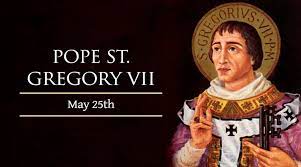On May 22 1073 during the Feast of Pentecost, the saint was ordained as a priest. On June 29, 1073, during the Feast of the Chair of St. Peter, he consecrated a bishop and enthroned as pope.
He was a great reforming pope, and is known best for the part he played in the Investiture Controversy. This Investiture controversy involved the ability and process of choosing and installing bishops, abbots, and the pope himself. During his dispute with Emperor Henry IV the primacy of papal authority was affirmed and also the new canon law that governs the election of the pope by the College of Cardinals.
It is known that, before he became pope, Pope Saint Gregory VII fostered the relationship between the emperor and the papacy. He rigorously enforced the Church’s policy of celibacy for the clergy and also condemned the practice of simony, which is the act of selling church offices and roles or sacred things.
Pope Gregory VII suspended all clerics who had attained their positions through simony. He also ordered the return of all property that had been purchased from the Church. Those corrupt clerics who were suspended rebelled against Pope Gregory and went to the fold of Emperor Henry IV who reinstated them.
Pope Gregory VII excommunicated anyone who was involved in lay investiture, including Emperor Henry IV. He summoned Emperor Henry IV to Rome, but the emperor’s supporters repelled Gregory and sent him into exile. After this Henry IV, in 1080 AD, appointed as pope, Guibert of Ravenna the archbishop of Ravenna, (he called himself pope Clement III) to oppose Pope Gregory VII in the political power struggles between the Catholic Church and his empire.
After Henry installed the anti-pope Guibert of Ravenna, Guibert was driven from Rome by Normans who supported Pope Gregory VII. These Normans went out of control such that the people of Rome, in retaliation, drove them out together with Pope Gregory.
Adapted from catholicreadings.org



